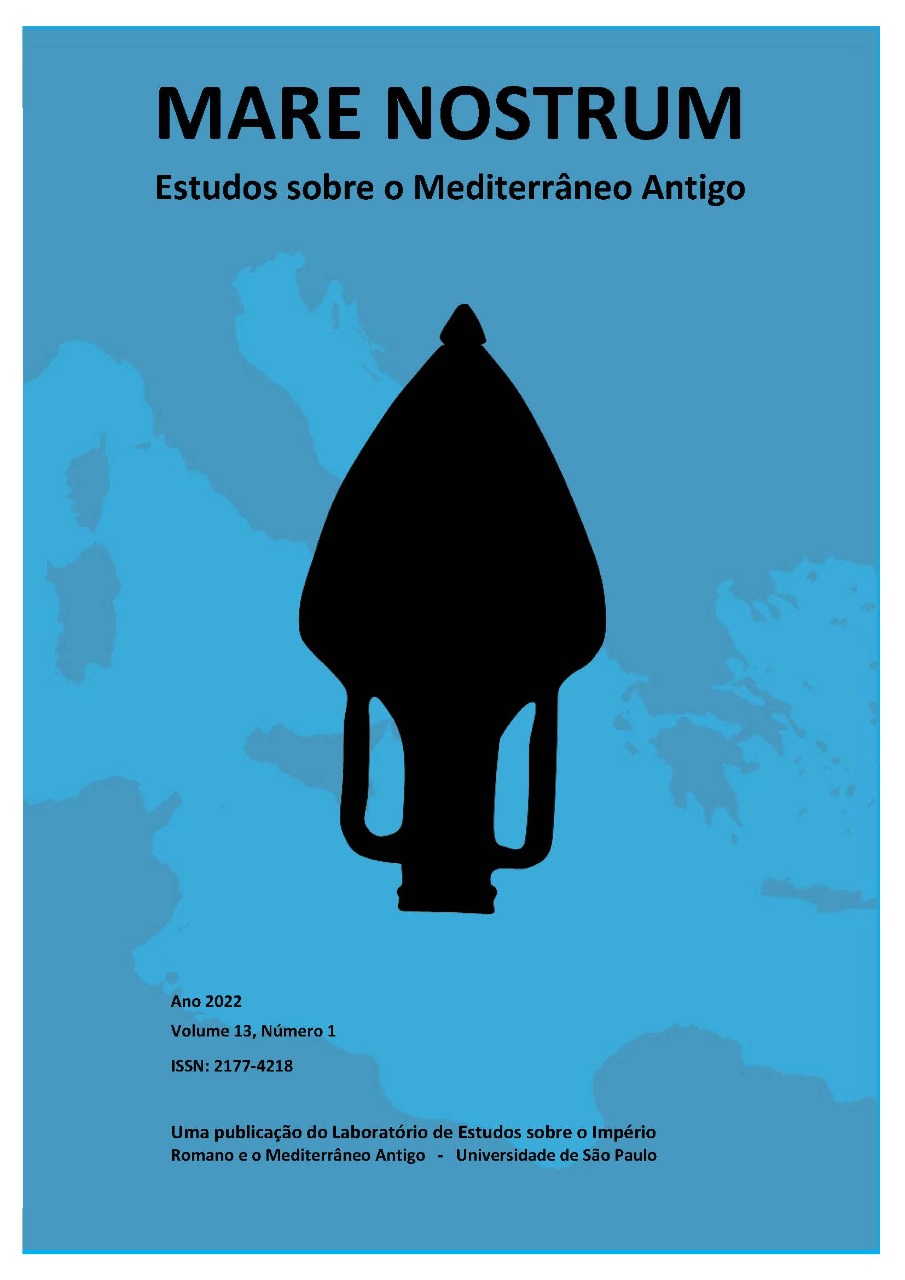Escribir, Sellar y Administrar. Una abordaje del corpus documental de la Tercera Dinastía de Ur a partir de la Epigrafía del Paisaje
DOI:
https://doi.org/10.11606/issn.2177-4218.v13i1p219-250Palavras-chave:
Epigrafía del Paisaje, Mesopotamia, Tercera Dinastía de Ur, textos administrativosResumo
En el presente artículo, se propone un abordaje de los textos administrativos de la Tercera Dinastía de Ur en Mesopotamia (c. 2110-2003 a.e.c.) – en particular, de las tablillas pisaĝ-dub-ba – a partir de una perspectiva teórico-metodológica que denominaremos Epigrafía del Paisaje. Por un lado, la importancia de la misma radica en entender a los documentos en sus mismos contextos de producción, circulación y almacenamiento, considerando sus componentes semántico-internos como sus componentes sintáctico-estructurales. Por otro, posibilita la comprensión y el reconocimiento, a partir de un riguroso abordaje de la documentación administrativa, de los (i) agentes (humanos y no humanos) junto a sus prácticas, los (ii) objetos/cosas (cultura material) y los (iii) lugares involucrados en la conformación de un paisaje social. Dicho paisaje social, en el caso de la Baja Mesopotamia, se componía de diferentes archivos provinciales, los cuales se subdividían en oficinas menores y otras mayores en tanto reguladoras de los distintos ámbitos económicos y políticos de la época. Finalmente, la propuesta teórico-metodológica aquí esbozada contribuirá en el análisis del engranaje que otorgaba sentido al edificio burocrático neo-sumerio, el cual se habría expresado a través de los mensajes contenidos en el registro documental y, de esta forma, se reforzaba la voz legítima del centro sobre los poderes locales.
Downloads
Referências
Appadurai, A. (1986). Introduction: Commodities and the Politics of Value. En A. Appadurai (Ed.), The Social Life of Things: Commodities in Cultural Perspective (pp. 3-63). Cambridge University Press.
Bajtín, M. (2002 [1979]). Estética de la creación verbal. Siglo XXI.
Cammarosano, M. (2014). The Cuneiform Stylus. Mesopotamia, 49, 53-85.
Chapman, H. (2006). Landscape Archaeology and GIS. History Press.
Chartier, R. (2006). Materialidad del texto, textualidad del libro. Orbis Tertius: Revista de Teoría y Crítica Literaria, 11(12). Recuperado de http://163.10.30.53/ojs_viejo/index.php/OT/article/view/OTv11n12a01/3774
Chartier, R. (2015). La main de l’auteur et l’esprit de l’imprimeur, xvie-xviiie siècle (Collection Folio histoire 243). Gallimard.
Criado Boado, F. (1993). Límites y posibilidades de la Arqueología del Paisaje. Spal. Revista de Prehistoria y Arqueología, 2, 9-55.
Criado Boado, F. (1999). Del terreno al espacio: planteamientos y perspectivas para la Arqueología del Paisaje (CAPA 6). LAFC, Universidad de Santiago de Compostela.
Cripps, E. (2017). The Structure of Prices in the Neo-Sumerian Economy (I): Barley: Silver Price Ratios. Cuneiform Digital Library Journal, 2. Recuperado de http://www.cdli.ucla.edu/pubs/cdlj/2017/cdlj2017_002.html
Edzard, D.O. (1976-1980). Keilschrift. Reallexikon der Assyriologie und Vorderasiatischen Archäologie, 5, 544-568.
Garfinkle, S.J. (2005). Public versus Private in the Ancient Near East. En D.C. Snell (Ed.), A Companion to the Ancient Near East (pp. 384-396). Blackwell Publishing.
Garfinkle, S.J. (2008). Was the Ur III State Bureaucratic? Patrimonialism and Bureaucracy in the Ur III Period. En S.J. Garfinkle & J.C. Johnson (Eds.), The Growth of an Early State in Mesopotamia: Studies in Ur III Administration. Proceedings of the First and Second Ur III Workshops at the 49th and 51st Rencontre Assyriologique Internationale, London July 10, 2003 and Chicago July 19, 2005 (pp. 55-61) (BPOA 5). CSIC.
Garfinkle, S.J. (2013). Ancient Near Eastern City-States. En P. Figiber Bang & W. Scheidel (Eds.), The Oxford Handbook of the State in the Ancient Near East and Mediterranean (94-119). Oxford University Press.
Gelb, I.J. (1967). Approaches to the Study of Ancient Society. Journal of the American Oriental Society, 87, 1-8.
Gelb, I.J. (1979). Household and Family in Early Mesopotamia. En E. Lipiński (Ed.), State and Temple Economy in the Ancient Near East: Proceedings of the International Conference Organized by the Katholieke Universiteit Leuven from the 10th to the 14th of April 1978 (pp. 1-97) (OLA 5). Departement Oriëntalistiek, Katholieke Universiteit Leuven.
Glassie, H. (1969). Pattern in the Material Folk Culture of the Eastern United States. University of Pennsylvania Press.
Glassie, H. (1999). Material Culture. Indiana University Press.
Gosden, C. & Marshall, Y. (1999). The Cultural Biography of Objects. World Archaeology: The Cultural Biography of Objects, 31(2), 169-178.
Grégoire, J.-P. (1981). L’origine et le développement de la civilisation mésopotamienne du troisième millénaire avant notre ère. En C.-H. Breteau, C. Lacoste-Dujardin, C. Lefebure & N. Zagnoli (Eds.), Production, pouvoir et parenté dans le monde méditerranéen de Sumer à nos jours (pp. 27-101). Éditions Paul Geuthner.
Hernando Gonzalo, A. (1999). El espacio no es necesariamente un lugar: en torno al concepto de espacio y a sus implicaciones en el estudio de la Prehistoria. Arqueología espacial, 21, 7-28.
Hicks, D. (2010). The Material-Cultural Turn: Event And Effect. En D. Hicks & M.C. Beaudry (Eds.), The Oxford Handbook of Material Culture Studies (pp. 25-98). Oxford University Press.
Hodder, I. (2011). Human-Thing Entanglement: Towards an Integrated Archaeological Perspective. Journal of the Royal Anthropological Institute, 17, 154-177.
Jagersma, B. (2010). A Descriptive Grammar of Sumerian. Tesis de doctorado. Universiteit Leiden.
Liverani, M. (1988). Antico Oriente. Storia, società, economia. Gius. Laterza & Figli.
Liverani, M. (2013). Immaginare Babele. Due secoli di studi sulla città orientale antica. Gius. Laterza & Figli.
Meskell, L. (2005). Introduction: Object Orientations. En L. Meskell (Ed.), Archaeologies of Materiality (pp. 1-17). Blackwell Publishing
Miller, D. (2005). Materiality. An Introduction. En D. Miller (Ed.), Materiality (pp. 1-50) (Politics, History, and Culture). Duke University Press.
Miller, D. (1987). Material Culture and Mass Consumption. Blackwell Publishing.
Molina, M. (2002-) (Ed.). BDTNS. Base de Datos de Textos Neosumerios. Recuperado de http://bdts.filol.csic.es
Molina, M. (2008). The Corpus of Neo-Sumerian Tablets: an Overview. En S.J. Garfinkle & J.C. Johnson (Eds.), The Growth of an Early State in Mesopotamia: Studies in Ur III Administration (pp. 19-53) (BPOA 5). CSIC.
Molina, M. (2016). Archives and Bookkeeping in Southern Mesopotamia during the Ur III Period. Comptabilités. Revue d’histoire des comptabilités, 8. Recuperado de http://journals.openedition.org/comptabilites/1980
Nelson, R.C. (1976). Pisan-dub-ba Texts from the Sumerian Ur III Dynasty. Tesis de doctorado. University of Minnesota.
Oppenheim, A.L. (1964 [1977]). Ancient Mesopotamia: Portrait of a Dead Civilization. University of Chicago Press.
Peirce, C.S. (1931-1935). The Collected Papers of Charles Sanders Peirce, v. 2, ed. de C. Hartshorne & P.Weiss. Harvard University Press.
Piquette, K.E. & Whitehouse, R.D. (2013). Introduction: Developing an Approach to Writing as Material Practice. En K.E. Piquette & R.D. Whitehouse (Eds.), Writing as Material Practice: Substance, Surface and Medium (pp. 1-13). Ubiquity Press.
Postgate, J.N. (1992). Early Mesopotamia: Society and Economy at the Dawn of History. Routledge.
Preucel, R.W. (2006). Archaeological Semiotics. Blackwell.
Rede, M. (1996). História a partir das coisas: tendências recentes nos estudos de cultura material. Anais do Museu Paulista: História e Cultura Material, 4(1), 265-282.
Rede, M. (1999). Complexidade social, sistemas comunicativos e gênese da escrita cuneiforme. Classica - Revista Brasileira de Estudos Clássicos, 11(11/12), 37-59.
Rede, M. (2000-2001). Estudos de cultura material: uma vertente francesa. Anais do Museu Paulista: História e Cultura Material, 8(1), 281-291.
Rede, M. (2007). Família e patrimônio fundiário: notas para o estudo da economia doméstica na antiga Mesopotâmia. História e Economia. Revista Interdisciplinar, 3(1), 71-102.
Renger, J. (1995). Institutional, Communal, and Individual Ownership or Possession of Arable Land in Ancient Mesopotamia from the End of the Fourth to the End of the First Millennium B.C. Chicago Kent Law Review, 71(1), 269-319.
Richardson, S. (2014). Mesopotamian Political History: The Perversities. Journal of Ancient Near Eastern History, 1(1), 61-93.
Sallaberger, W. (1993). Der kultische Kalender der Ur-III-Zeit (Untersuchungen zur Assyriologie und Vorderasiatischen Archäologie. Ergänzungsbände zur Zeitschrift für Assyriologie und Vorderasiatische Archäologie 7/1). Walter de Gruyter Inc.
Sallaberger, W. (1999). III Dinastía de Ur-Zeit. En W. Sallaberger & A. Westenholz (Eds.), Mesopotamien: Akkade-Zeit und III Dinastía de Ur-Zeit (pp. 119-390) (OBO 160/3). Universitätsverlag Freiburg/Vandenhoeck & Ruprecht.
Sallaberger, W. & Schrakamp, I. (Eds.) (2015). History and Philology (ARCANE 3). Brepols.
Saussure, F. de. (1995 [1916]). Curso de lingüística general. Losada.
Schloen, J.D. (2001). The House of the Father as Fact and Symbol: Patrimonialism in Ugarit and the Ancient Near East (SAHL 2). Eisenbrauns.
Soja, E. (1996). Thirdspace: Journeys to Los Angeles and Other Real-and-Imagined Places. Blackwell.
Steinkeller, P. (2003a). An Ur III Manuscript of the Sumerian King List. En W. Sallaberger, K. Volk & A. Zgoll (Eds.), Literatur, Politik und Recht in Mesopotamien: Festschrift für Claus Wilcke (pp. 267-292). Harrasowitz.
Steinkeller, P. (2003b). Archival Practices in Babylonia in the Third Millenium. En M. Brosius (Ed.), Ancient Archives and Archival Traditions: Concepts of Record-Keeping in the Ancient World (pp. 37-58). Oxford University Press.
Steinkeller, P. (2004). The Function of Written Documentation in the Administrative Praxis of Early Babylonia. En M. Hudson & C. Wunsch (Eds.), Creating Economic Order: Record-Keeping, Standardization, and the Development of Accounting in the Ancient Near East. A Colloquium Held at the British Museum, November 2000 (pp. 65-88) (ISCANEE 4). CDL.
Steinkeller, P. (2013). Corvée Labor in Ur III Times. En S.J. Garfinkle & M. Molina (Eds.), From the 21st Century B.C. to the 21st Century A.D. Proceedings of the International Conference on Sumerian Studies Held in Madrid 22-24 July 2010 (pp. 347-424). Eisenbrauns.
Taylor, J. (2011). Tablets as Artefacts, Scribes as Artisans. En K. Radner y E. Robson (Eds.), Oxford Handbook of Cuneiform Culture (pp. 5-31). Oxford University Press.
Tilley, C. (1991). Material Culture and Text: the Art of Ambiguity. Routledge.
Tilley, C. (1999). Metaphor and Material Culture. Blackwell.
Tsouparopoulou, C. (2013). Reflections on Paratextual Markers and Graphic Devices in Ur III Administrative Documents. Textual Cultures, 8(2), 1-14. DOI: 10.14434/tc.v8i2.13276
Tsouparopoulou, C. (2015). Spreading the Royal Word: The (Im)Materiality of Communication in Early Mesopotamia. En S. Enderwitz & R. Sauer (Eds.), Communication and Materiality in Pre-Modern Societies (pp. 7-23) (Materiale Textkulturen 8). Walter de Gruyter Inc.
Ur, J. (2014). Households and the Emergence of Cities in Ancient Mesopotamia. Cambridge Archaeological Journal, 24(2), 249-268.
Van de Mieroop, M. (1999). Cuneiform Texts and the Writing of History. Routledge.
Veldhuis, N. (2011). Levels of Literacy. En K. Radner & E. Robson (Eds.), The Oxford Handbook of Cuneiform Culture (pp. 68-89). Oxford University Press.
Wagstaff, J.M. (Ed.). (1987). Landscape and Culture: Geographical and Archaeological Perspectives. Blackwell.
Yoffee, N. (2004). Myths of the Archaic State: Evolution of the Earliest Cities, States and Civilizations. Cambridge University Press.
Yoffee, N. y Seri, A. (2019). Negotiating Fragility in Ancient Mesopotamia: Arenas of Contestation and Institutions of Resistance. En N. Yoffee (Ed.), The Evolution of Fragility: Setting the Terms (pp. 183-196). McDonald Institute for Archaeological Research, University of Cambridge.
Zólyomi, G. (2017). An Introduction to the Grammar of Sumerian. Eötvös University Press.
Downloads
Publicado
Edição
Seção
Licença
Copyright (c) 2022 Rodrigo Cabrera

Este trabalho está licenciado sob uma licença Creative Commons Attribution 4.0 International License.
Os conteúdos expressos nos textos publicados pela Mare Nostrum são de exclusiva responsabilidade de seus respectivos autores.
A reprodução dos textos editados pela Mare Nostrum é permitida sob licença Creative Commons, Atribuição-NãoComercial (CC BY-NC).
Autores que publicam nesta revista concordam com os seguintes termos:
- Autores mantém os direitos autorais e concedem à revista o direito de primeira publicação, com o trabalho simultaneamente licenciado sob a Licença Creative Commons Attribution que permite o compartilhamento do trabalho com reconhecimento da autoria e publicação inicial nesta revista.
- Autores têm autorização para assumir contratos adicionais separadamente, para distribuição não-exclusiva da versão do trabalho publicada nesta revista (ex.: publicar em repositório institucional ou como capítulo de livro), com reconhecimento de autoria e publicação inicial nesta revista.
- Autores têm permissão e são estimulados a publicar e distribuir seu trabalho online (ex.: em repositórios institucionais ou na sua página pessoal) a qualquer ponto antes ou durante o processo editorial, já que isso pode gerar alterações produtivas, bem como aumentar o impacto e a citação do trabalho publicado (Veja O Efeito do Acesso Livre).









